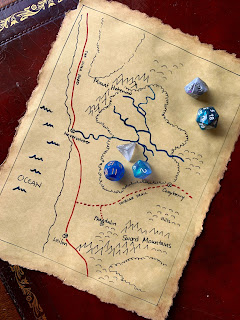Real Life Challenge Ratings
In fifth edition D&D, characters gain hit points at a faster rate than damage dealt by comparable monsters. The foes matched against 1st-level characters make for dangerous encounters, but at level 8 or so, the game’s advice for building encounters leads to overmatched monsters. By the highest levels, the monsters can feel hopeless.
I'll spoiler his solution, which is based on the work of Adventurers League Administrator and game designer Alan Patrick, and that is to scale up damage dealt by monsters to close the gap. (Despite my spoiler, the article is well worth reading for its explanation as to why, so go read it.) I read the article and sat back and considered this while I sipped my morning coffee.
I am often philosophical in the liminal parts of the day - the beginnings and ends of things make me reflective, even if those beginnings and endings are common. And so I immediately transitioned to how well the game's tier system reflects a real-life trajectory... and the short answer of course is that it doesn't. In real life, people do not consistently and regularly increase their skillsets in ways that mitigate damage to the point where success is largely inevitable.
Nu. Nobody ever intended the game to mirror real life - it's an escape, after all.
And yet, there's something here worth looking at. Without that properly scaled challenge, the game becomes predictable and boring, the DM becomes frustrated, overwhelmed and courts a sense of inadequacy, and the impetus to play evaporates. Nobody plays an escapist game to feel bored or inadequate. I'm guessing it's one of several reasons that most people playing D&D are playing tiers 1 and 2.
How does the scaling of conflict and resolution in D&D dovetail with my philosophical comparison with real life? Well, I haven't found that life gets easier with age. And I should make an important distinction - it is possible for life to get better without getting easier. Still, while older people do have a disproportionate amount of influence in the world, most aren't in that position. There are far fewer 85 year olds kicking ass and taking names than those suffering poverty, disenfranchisement and disappointment.
On a personal level, the troubles I dealt with as a child and teenager are different in nature than the troubles I face as an adult, especially in regard to who has agency and what sort of resources I can bring to bear. But in terms of urgency and threat to happiness, I'd say that the stakes remain pretty constant. To use the imperfect metaphor that is D&D, the damage scales with level. And there's the caveat that no matter how much you improve your wisdom stat, ultimately the wear and tear of life takes your constitution to zero. What makes it a good story along the way is whether or not you are evenly matched to your challenges over the long haul. And isn't that what we're trying to do in life? Make our story a good one?
Does increasing the damage dealt by adversaries tighten the metaphor of D&D to life? I'm not sure it does. It strikes me that most enemies in D&D are external, whereas it's a mixed bag in life... some people truly have external forces keeping them down, whereas others are debilitated from within. And there is more oscillation in real life, as well. Life is a series of hills and valleys as adversity is followed by learning, and then a new adversity arrives on the scene. People who are positioned to learn ultimately gain in wisdom, and perhaps this makes subsequent hills a little easier to climb. And some people get stuck in valleys, cast in shadow and unable to find a way out. And then there are those who are blind to it all, without comprehension. Occasionally some event transpires that changes a person's circumstances permanently, but most of the time life is a slow oscillating rise or fall playing out unremarkably over the course of decades. It is a hugely transformative process, but also relentlessly incremental. How many people who knew me at 8 years old still know me now? Those people who I have not seen in nearly 45 years - would they recognize me? Is the throughline of who I am as clear as it is in a character sheet that has leveled from 1 to 20? My ideals, my goals, my flaws... even my personality traits have changed.
In game or out of it, we yearn for climbable hills. Walking a flat plane gives no glory, no sense of accomplishment or triumph. And hills that are too steep remind us too keenly of how large the universe is, and how small we are.
I finished my coffee as I thought of the past year. So many oscillations. I wrote a very detailed supplement to Curse of Strahd for making a fully illustrated and bound Tome and put it up for sale on The Dungeon Masters Guild. Life happened and I never had the chance to fully promote it. I dropped a game. Picked it back up again. Joined another which has since stagnated. Introduced some friends to D&D but haven't had the chance to write about it. Stopped taking dice photos, but kickstarted my 'real life' career instead. Had a great idea for a D&D podcast, but cannot devote the time and energy to make it happen. Started re-entering the world again. Retreated as Delta variant took hold.
Each crest, each trough, they push me down time's linear path, until with either one cataclysmic wave... or perhaps a gentle dampening of amplitude or lengthening of wavelength, my waveform goes still, replaced by others. But I am so concerned with clinging to each crest or scrambling out of each trough that I don't always see the overall trajectory.



Comments
Post a Comment